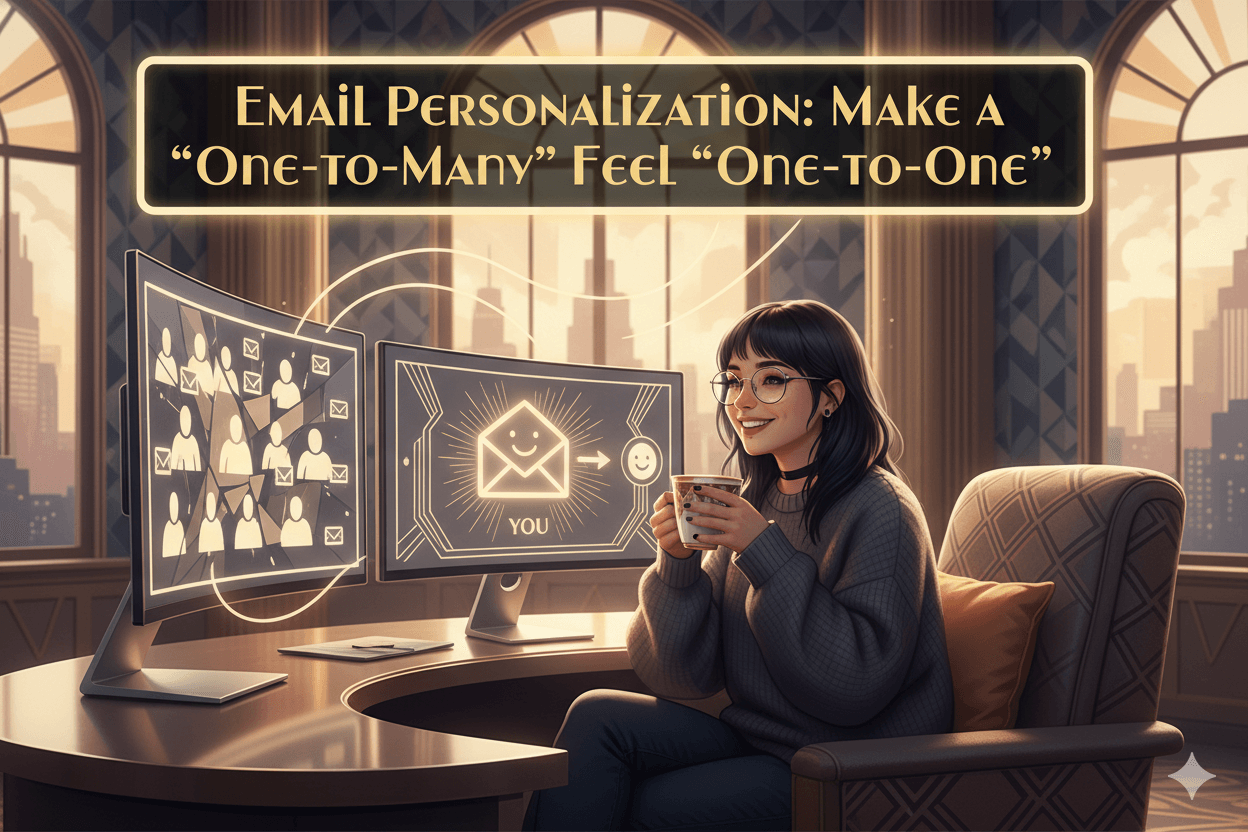Best Choice
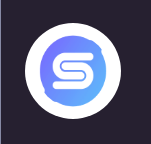
Scale gg
Because personalized experiences feel relevant, you’ll get higher engagement: visitors stay longer, click more, opt-in more, and convert at better rates.
Best for Agencies

GoHighLevel
You can clone and adapt personalization templates across multiple clients, saving hours of design and setup work while maintaining unique experiences.
Best for Small Businesses

Click Funnels
It turns your website into an active salesperson …one that speaks differently to each customer, increasing sales while you focus on running your business.
Friend to friend: a few links are affiliate links. When you purchase, I might get a tiny thank-you from the company, with zero added cost to you. I only recommend things that I’ve actually tried and looked into. Nothing here is financial advice; it is for entertainment. Read the full affiliate disclosure and privacy policy.
Your site can qualify people in the time it takes to sip coffee. Personalize the page for what brought them in, invite a tiny quiz or guided chat, and send the right visitors to a live calendar.
You can launch this without developers, heavy tools, or long delays. It’s a simple motion that feels helpful to the visitor and practical for a small team.
Here’s the quick path you’ll use… and keep using: tailor the page to intent, ask a few plain questions to collect consented answers, and watch for signals like pricing views and return visits.
Score those moments simply, then route qualified visitors straight to a rep’s calendar. Keep it lightweight and no-code. Prioritize first-party data, clear consent, and fast handoffs.
Aim for sub-five-minute response, measure booked meetings and SQL rate, and iterate weekly as you learn.

Personalize to Qualify: The Fast-Path Model
Personalization earns you speed. Read signals, ask two smart questions, and send ready buyers straight to a calendar under five minutes.
What counts as first-party on your site?
First-party data is information you collect directly from interactions on your own properties: pages viewed, time on high-intent pages, return visits, and actions like form fills or chats.
Zero-party data is what a visitor explicitly shares through a quiz or survey. Both power compliant, relevant experiences for SMBs. Use them to tailor CTAs and questions on the next screen.
Pro tip: Pair behavioral signals (pricing page view, repeat visit) with one or two explicit questions (goal, timeline) to qualify without friction. Then store consent along with answers.
Real-time signals you can read in session
At minimum, read referrer/UTM, page path, geo, device, and recency; then adapt copy, offer, or entry point to a quiz or chat.
Modern platforms define web personalization as creating unique experiences based on characteristics and behaviors and can update the experience mid-session as intent changes.
Start with rule-based segments before you add heavier AI.
Quick_win: If a visitor hits pricing or “book a demo,” surface a two-question gate that asks use-case and timeline, then show a scheduler when answers meet your threshold.
Why five minutes sets the bar
Response time decides the outcome. The classic MIT/InsideSales research found the odds of contacting a lead within five minutes can be up to 100× higher than waiting 30 minutes, and qualification odds fall steeply with delay.
Later analyses show conversion rates can be about 8× higher when contact happens inside five minutes. This is why the model ties personalization to immediate routing and instant scheduling.
The 10-Minute Build: From Segment Rules to First Booking
You can ship this today. Set three segments, add a two-question fit check, and show a calendar when the score pops.
Set three segments and one dynamic CTA
Create three lightweight segments from data you already have: source/UTM, page path, and geo or device. Show a tailored call-to-action for each.
For example, pricing-page visitors see “Get a quick fit check” while blog readers see “Find your best plan.”
Foundational definitions from leading platforms support rule-based personalization before heavier models, and journey orchestration guides confirm you can update mid-session as intent changes.
Quick_win: If the visitor lands from a high-intent UTM and hits pricing, raise a “two-question fit check” CTA. If they answer favorably, promote “Book now” rather than “Learn more.” – InsideSales
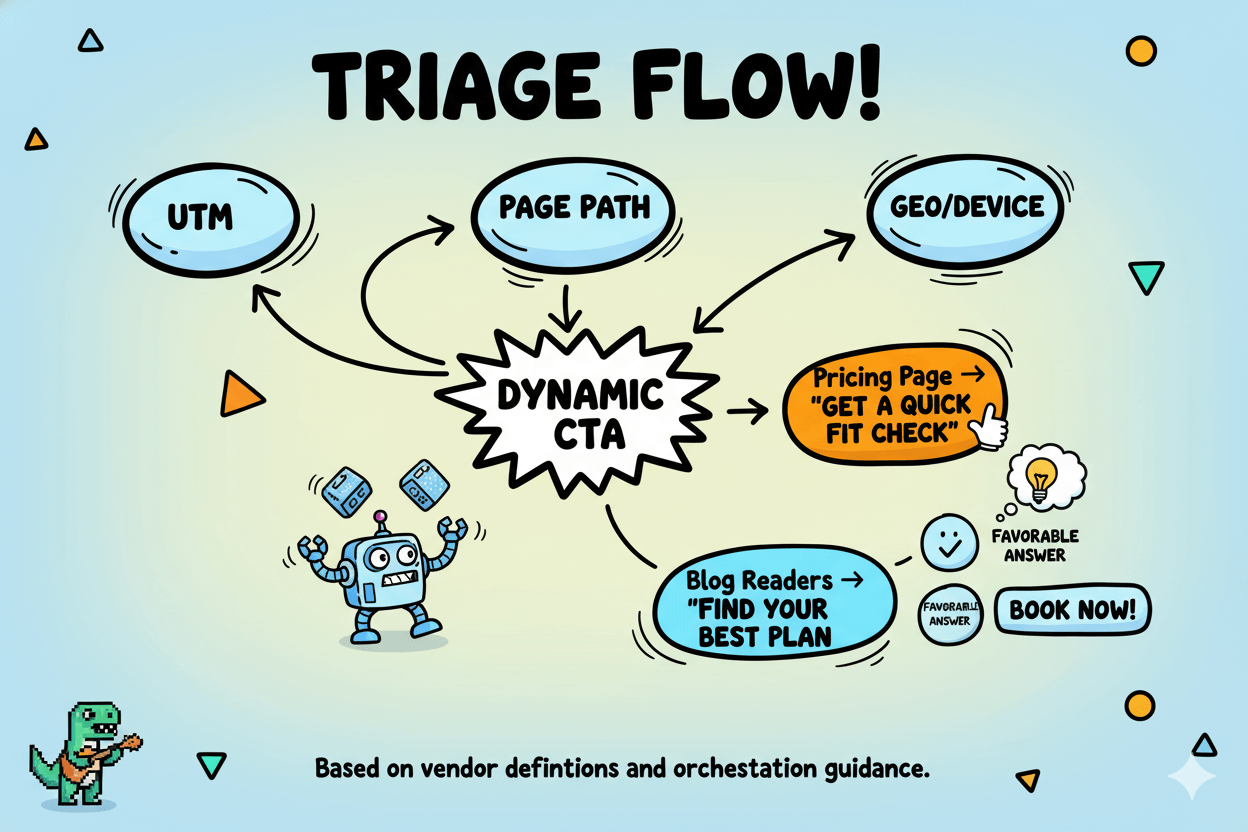
Add a quiz or chat gate aligned to intent
Use a 7–10 question quiz or a guided chat to capture consented answers about goals, timeline, role, and ballpark budget. Pass those fields to your CRM so they enrich the contact record and drive workflows. Vendor documentation shows this pattern: collect first-party data, set or update score properties, and trigger downstream automations.
do’s_and_don’ts:
- Do branch outcomes to tailored next steps; don’t force the same CTA for everyone.
- Do keep questions simple and optional; don’t bury the calendar behind long forms.
Route hot leads to instant scheduling
When the score crosses your threshold, remove the wait. Show the correct rep’s calendar at form submit or right inside chat.
This “instant inbound” pattern compresses speed-to-lead and is documented by meeting-automation providers and conversion platforms alike.
Real-time qualification, intelligent routing, and embedded scheduling reduce drop-off between interest and first conversation. – Chili Piper
Myth_buster: You don’t need a phone call first. If the visitor is qualified, let them self-book now. Case materials and product pages show meeting booking from web forms and chat with rules for territory, ownership, or VIP handling.
Micro_challenge: Ship a minimum viable build today.
- Define three segments and one dynamic CTA.
- Add a two-question gate for pricing visitors.
- Pass answers to your CRM as score inputs.
- If score ≥ threshold, display the rep’s live calendar instantly.
Quiz Funnels that Qualify in Minutes
A quiz feels like help, not friction. Seven to ten questions branch to useful answers and a next step that fits.
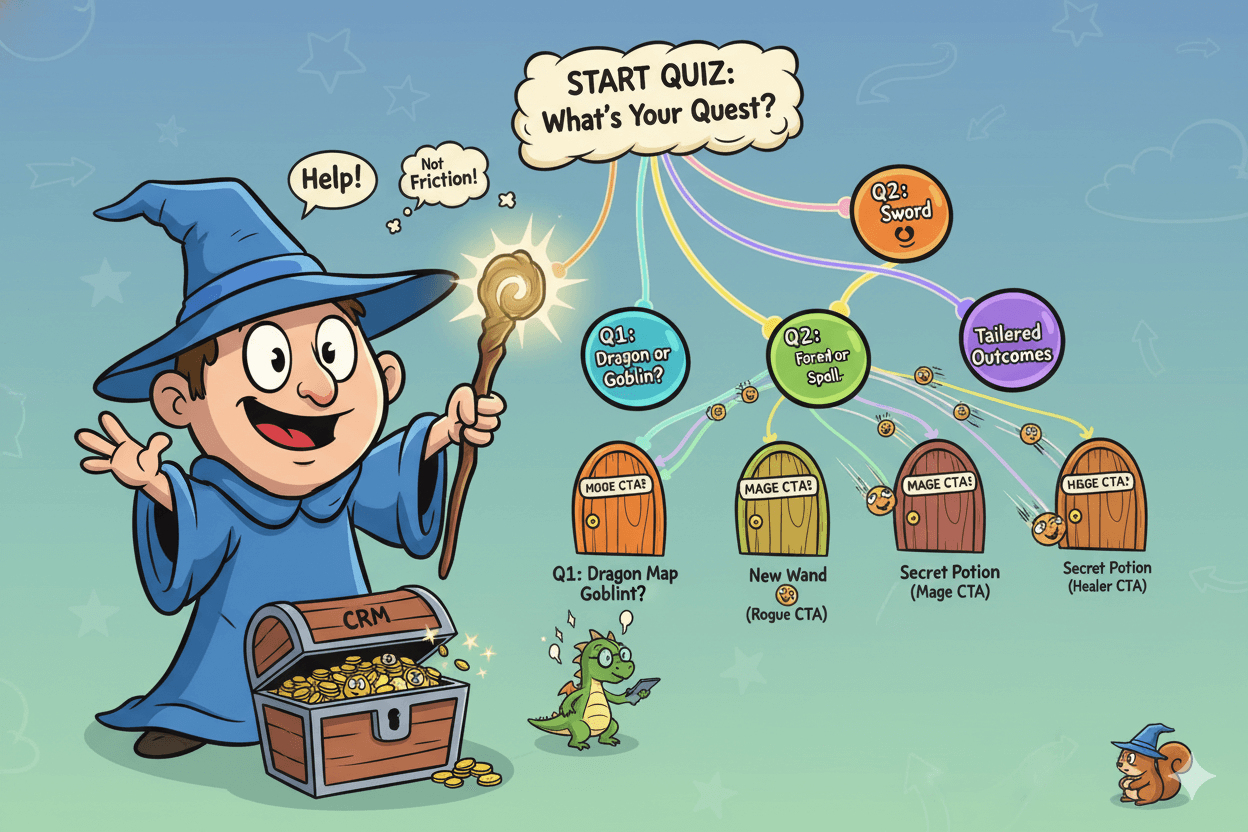
Branching logic that feels helpful
Start with three paths: “Just exploring,” “Problem solving now,” and “Ready to buy.”
Ask plain-language questions about goals, use-case, timeline, role, and ballpark budget. Show outcome pages that read like advice, not a pitch, and pair each with a specific CTA: “See your plan,” “Get a quick fit check,” or “Book now.”
Interact’s playbooks emphasize outcomes that summarize results and link to the right follow-up content; their B2B examples show branching embedded in blogs and landing pages.
Pro_tip: Use ranges instead of exact numbers for budget and timeline. Completion stays high while still signaling urgency.
Map answers to a score and the next step
Give each answer a few points toward readiness: urgent timeline, economic buyer role, high-impact use-case, and “looked at pricing before” can each add weight.
Sum it with simple rules to produce one of three outcomes: nurture, talk-to-human, or book-now.
Vendor guides show this pattern boosting B2B conversion by collecting structured data, segmenting leads, and enabling personalized follow-up at scale. – Instapage
Before_after:
Before: one generic ebook gate, low reply rates.
After: quiz routes “ready now” to a calendar, “curious” to a comparison page, and “not a fit” to a soft nurture.
Pass data to your CRM and email
Make every answer usable. Connect the quiz directly to your CRM so contacts, properties, and lists update in real time.
Interact and ScoreApp both provide native HubSpot integrations to push quiz fields, enroll contacts in workflows, and update properties for scoring and segmentation.
If you prefer middleware, Zapier or similar can create HubSpot submissions the moment a quiz completes. Support docs also show mapping UTMs into CRM fields, so you preserve campaign context alongside quiz results.
With that pipe in place, your “book now” branch can trigger routing and scheduling immediately.
Micro_challenge: Publish one quiz this week. Reuse a proven B2B template, set three outcome pages with distinct CTAs, map five fields into your CRM, and enroll “ready now” in an instant-booking workflow.
A Simple Behavior Score You Can Ship Now
No model needed. Add points for pricing views, return visits, and urgent timelines; subtract for long gaps.
The core signals: depth, recency, intent pages
Anchor your “ready now” score to actions that correlate with purchase: pricing and plan pages, demo or trial requests, product comparison content, and configurators.
Weight recency and velocity so a cluster of actions this week beats scattered clicks over months. Use negative scoring for long gaps to keep the list clean. These practices are consistent across recent guides and 2025 playbooks.
Template: Starter weights
- Pricing page view: +15
- Demo/trial request: +25
- Return visit within 7 days: +10
- Product comparison page: +12
- Watched product video ≥50%: +8
- Inactive 30 days: −15
Adjust to your cycle length and sales capacity.
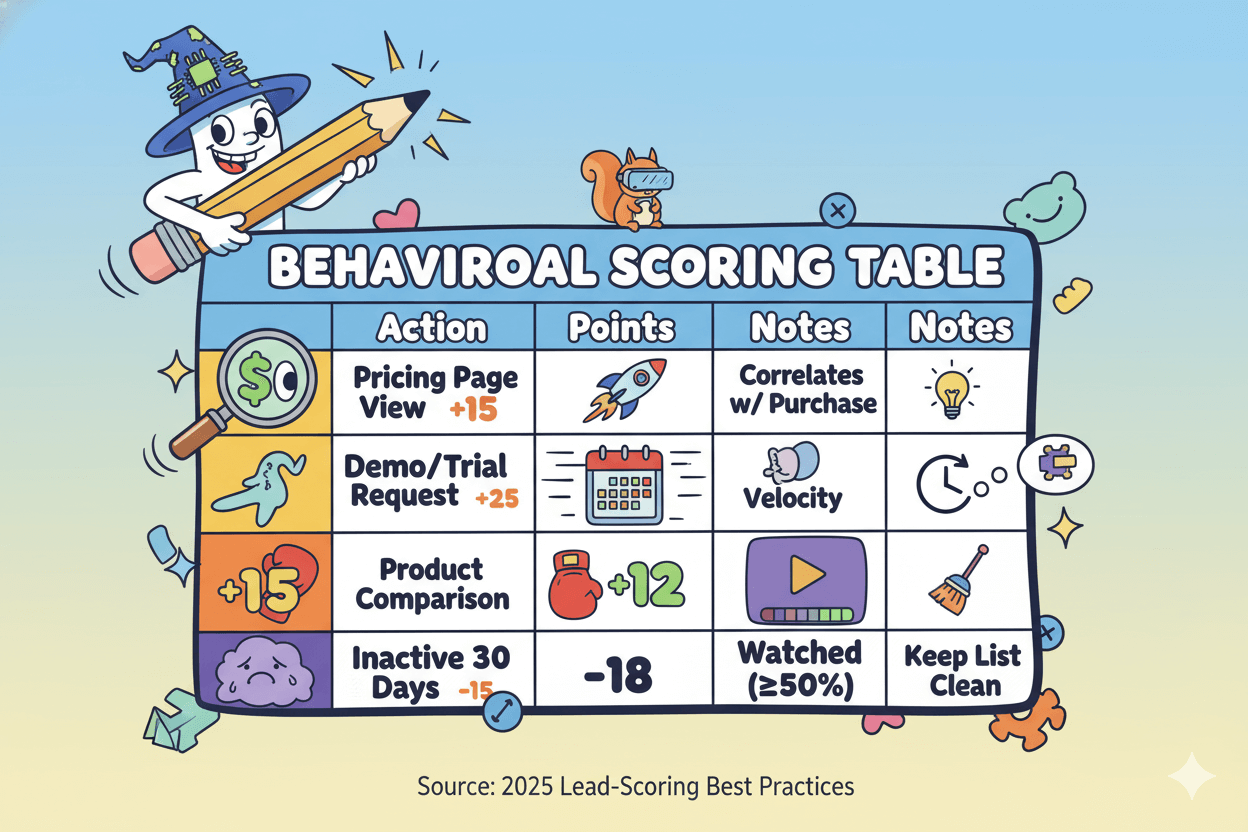
Thresholds and actions inside HubSpot
Implement the score where sales lives.
HubSpot’s updated Lead Scoring tool lets you create engagement, fit, and combined scores; you can view performance, tune rules, and trigger workflows when a threshold is reached (for example, show calendar at submit or notify the right rep).
HubSpot retired legacy “score properties” in 2025, so use the new tool for ongoing updates and analysis.
Quick_win: Create a combined score: engagement ≥40 and fit ≥10 routes to instant scheduling; engagement 25–39 sends to live chat; below 25 enrolls in a short nurture. Tune weekly using the score performance view.
When to test predictive scoring
Keep rules first while data is sparse. Once you have steady labeled outcomes, pilot predictive scoring to estimate likelihood-to-close and surface non-obvious patterns.
Treat it as an overlay, not a black box: compare lift against your rules and keep human-readable triggers for sales. HubSpot documents predictive scoring concepts and how probability values map to close odds.
Under Five Minutes: Routing and Instant Scheduling
Speed decides outcomes. Auto-assign an owner and show the right calendar at submit so intent doesn’t cool.
Round-robin, ownership, and VIP rules
Use round-robin pools for fairness and fast assignment across available reps. It scales as people join or pause without stalling distribution.
Layer territory or account ownership for known-company matches, and add VIP overrides to bypass queues. Routing tools document these patterns and provide SLA automation to keep leads moving even when teams are complex.
Quick_win: Create two flows: (1) net-new, unknown account → round-robin SDR; (2) known account or active opportunity → assigned owner with priority alert. Review pool balance weekly to prevent silent bottlenecks.
Book it now: embed scheduling at submit
Collapse the gap between form and first conversation. Meeting-automation platforms let qualified visitors book the correct rep immediately after form submit, or inside a live chat experience.
This cuts response time to seconds and reduces no-shows created by delayed email ping-pong. Platform docs show instant qualification, rep matching, and calendar booking directly from the website.
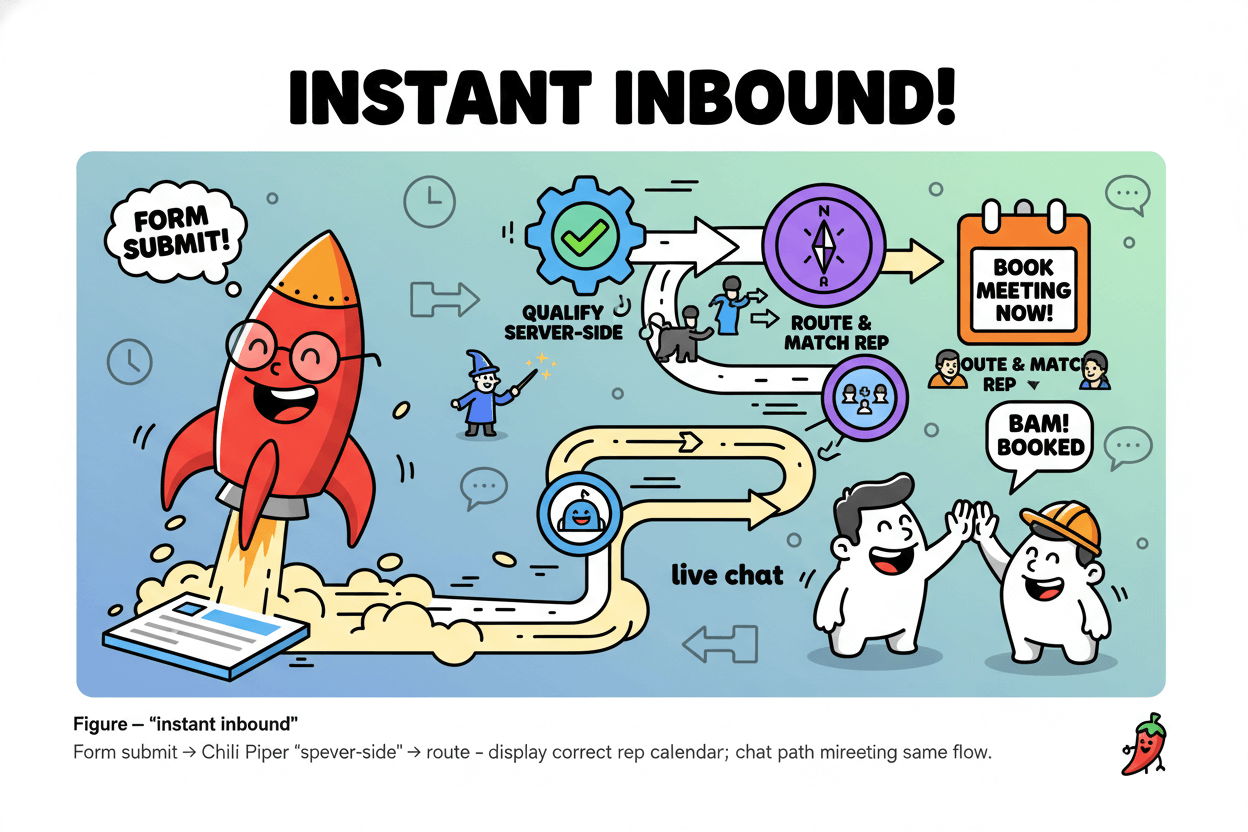
After-hours logic and escalations
Keep your five-minute standard 24/7 with smart failovers. If no rep is online, show pooled calendars for the next morning, route to a regional queue, or let a sales chatbot qualify and book automatically.
Intercom’s scheduling apps and chatbots support meeting booking even when your team is offline, preserving momentum from high-intent visits.
do’s_and_don’ts:
- Do alert the assigned rep and a backup channel on every instant booking; do log SLA breaches for weekly review.
- Don’t hide schedules behind long email threads; don’t leave VIP traffic in generic queues.
Proof point: Foundational research reports contact odds dropping up to 100× from five to thirty minutes; later summaries show conversion rates can jump more than 8× when attempts happen in the first five minutes.
These data support making routing and scheduling automatic rather than manual.
Measure What Matters: From Variant to Pipeline
Prove it with a holdout. Track bookings, SQL rate, pipeline, and response time—then publish the lift.
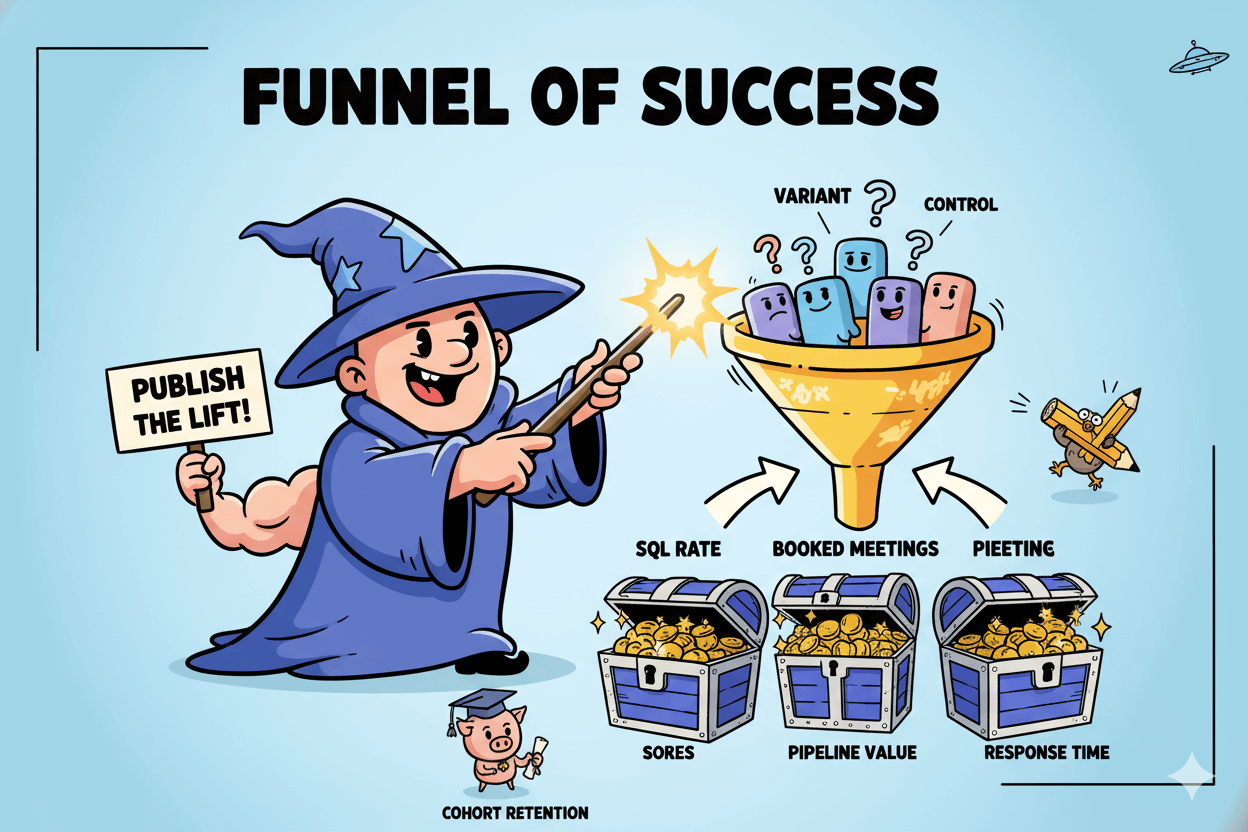
Event map from first click to booked meeting
Instrument a linear chain: page variant seen → quiz started → quiz completed → qualified by score → routed → booked meeting. A holdout test isolates the incremental lift of personalization versus what would have happened anyway.
Save a small, random cohort as control; attribute differences in booking rate and SQL rate to the treatment. This is the cleanest way to prove causality without overcounting.
Pro_tip: Add response-time as a metric. Faster handoffs correlate with higher connect and conversion odds, so show median minutes-to-first-touch beside bookings. If your embedded scheduling collapses response time, you should see bookings rise in the variant.
SQL and pipeline definitions you can trust
Lock shared definitions before you test. Use an MQL threshold tied to engagement plus fit, then promote to SQL when a lead is ready for direct sales contact and meets agreed criteria.
Consistent SQL criteria make your lift numbers credible and repeatable across campaigns and seasons.
Template — scoreboard fields
- Variant vs. Control traffic
- Quiz completion %
- Qualified rate %
- Booked meetings %
- SQL rate %
- Pipeline value and cycle time
- Median response time (minutes)
Reporting cadence and SLA dashboard
Run each test to significance and report weekly. Segment results by source/UTM and intent page so you can see where personalization does the work.
For executive rollups, lead with SQL rate and booked meetings; include response-time trend lines to connect “minutes” to outcomes.
Fresh research syntheses show broad adoption and budget for personalization, but the win appears in meeting rate and pipeline, not only in engagement curves. Keep your variant running and rotate new experiments as baselines stabilize.
Before_after:
Before: page variants tracked to CTR only.
After: variant tracked to booked meetings and SQL, with a holdout proving incremental lift, and a dashboard tying improved response time to higher bookings.
Tool Options by Budget and Stack Maturity
Start small, scale smart. Pair a rules-first personalizer, one quiz tool, and an instant-booking router.
Starter stack for solo to 3-person teams
- Personalization: Use a rules-first platform that lets you target by UTM, path, geo, or behavior and swap CTAs or modules without code. Optimizely’s guides cover 1:1 concepts while supporting pragmatic rule-based starts. Bloomreach shows how on-site changes can run from the same journey logic as email and SMS.
- Quiz capture: Launch a 7–10 question quiz that passes fields to your CRM. ScoreApp offers direct HubSpot integration and field mapping; their step-by-step shows how to sync properties for workflows.
- Instant booking: Add form- or chat-triggered scheduling so qualified visitors book in-flow. Chili Piper’s Instant Inbound pattern qualifies, routes, and displays the right calendar immediately.
Result: Personalize the page, capture consented answers, and book meetings in minutes without a heavy build.
Growing stack for 4–10
- Personalization depth: Keep rule targeting, then layer experiments and broader scenarios. Dynamic Yield’s comprehensive guide details data sources, targeting, and scaling tactics. Bloomreach’s strategy posts outline cross-channel orchestration as teams mature.
- Conversation to pipeline: Pair site chat that qualifies with “book-now” flows. Qualified documents AI-assisted website conversion and meeting workflows designed for B2B. Chili Piper’s speed-to-lead article explains why embed-at-submit cuts response time to seconds. – Sender
- Routing at scale: As owners, territories, and VIP rules multiply, LeanData provides pattern-based inbound routing and SLA enforcement; their resources and ebook cover queue design and failovers.
Outcome: Less leakage between interest and first meeting, plus cleaner assignment logic as rep count grows.
Integration checklist before you buy
- Data in, data out. Confirm your quiz can push declared answers and UTMs directly into CRM properties for scoring and workflows. ScoreApp→HubSpot docs show required field mapping.
- Real-time triggers. Your personalization layer should react mid-session to pricing views or return visits and switch the entry point to quiz or chat. Optimizely and Bloomreach both describe this reactive model.
- Routing + calendar in-flow. Ensure you can qualify server-side, match to owner or pool, and show the correct calendar instantly from form or chat. Chili Piper and Qualified document the full “instant inbound” motion.
- Orchestration headroom. As needs expand, verify roadmap fit for cross-channel orchestration and advanced targeting. Bloomreach and Dynamic Yield provide patterns for scaling without a rebuild.
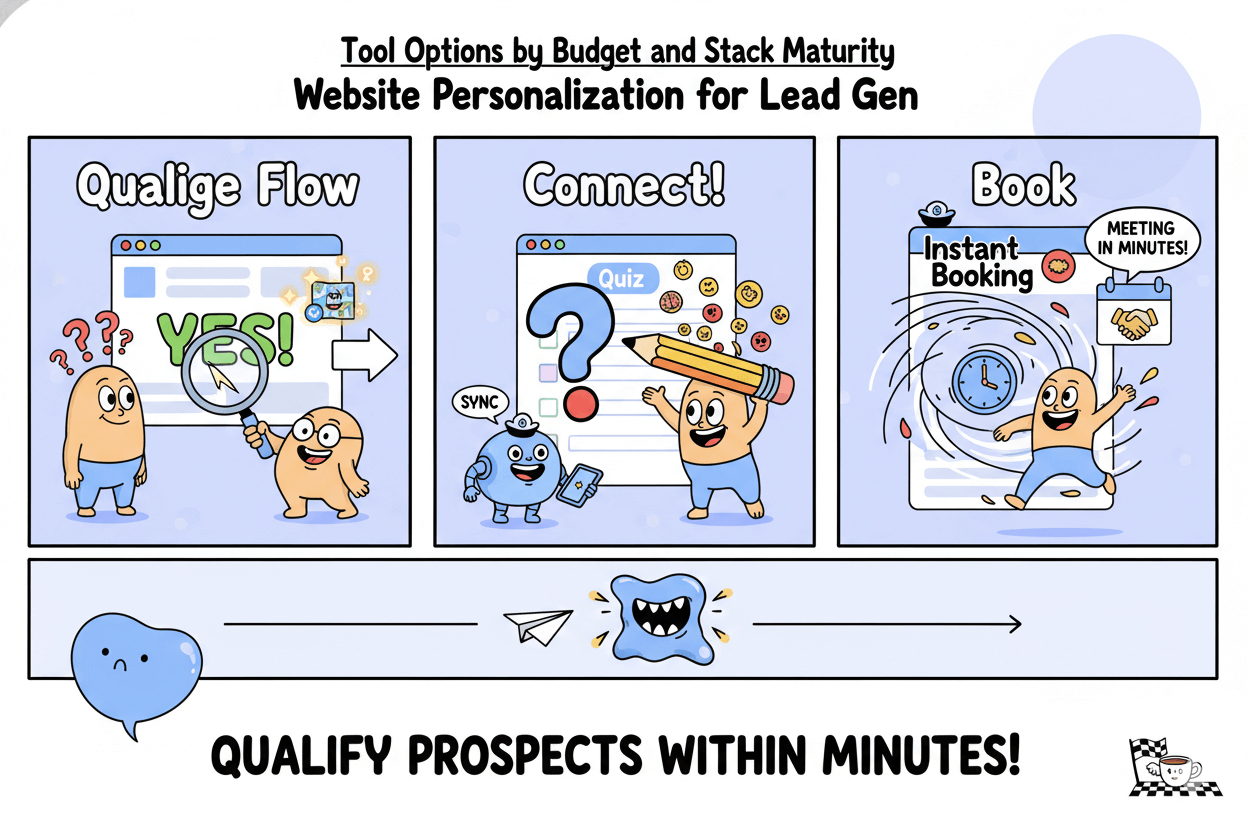
Decision tip: Favor vendors that publish clear, current playbooks and show working examples of rule targeting, CRM field sync, routing patterns, and embed-at-submit scheduling. The shorter the path from click to calendar, the better your “qualify in minutes” promise holds.
FAQs: Answering Clever Website Personalization Questions
Fast answers to real search questions—each sourced and under 90 words.
Quick answers set 1
Does website personalization improve lead quality?
Yes. Recent roundups show strong adoption and links to revenue and retention, with most leaders calling personalization essential and customers expecting it. Executed well, this shifts traffic toward higher-intent conversations and qualified pipeline.
What is speed-to-lead and why five minutes?
Speed-to-lead is your time to first response after a hand raise. Odds of contact and qualification drop steeply after 5–10 minutes; classic and recent analyses show the biggest gains when you engage inside five minutes.
How do quiz funnels qualify leads?
They collect consented answers, branch to relevant outcomes, and pass structured data to your CRM for segmentation and follow-ups. Modern quiz tools natively integrate with marketing stacks to automate this handoff.
Which on-site behaviors predict sales readiness?
Pricing and plan views, demo/trial requests, repeat visits, deep engagement on product pages, and chat with buying intent are reliable inputs in rule-based scoring models. Negative scoring for inactivity keeps queues clean.
How do I build the end-to-end funnel?
Segment by source/path, present a short quiz or guided chat, score behavior plus answers, route automatically, and display the correct calendar in-flow so qualified visitors can book immediately.
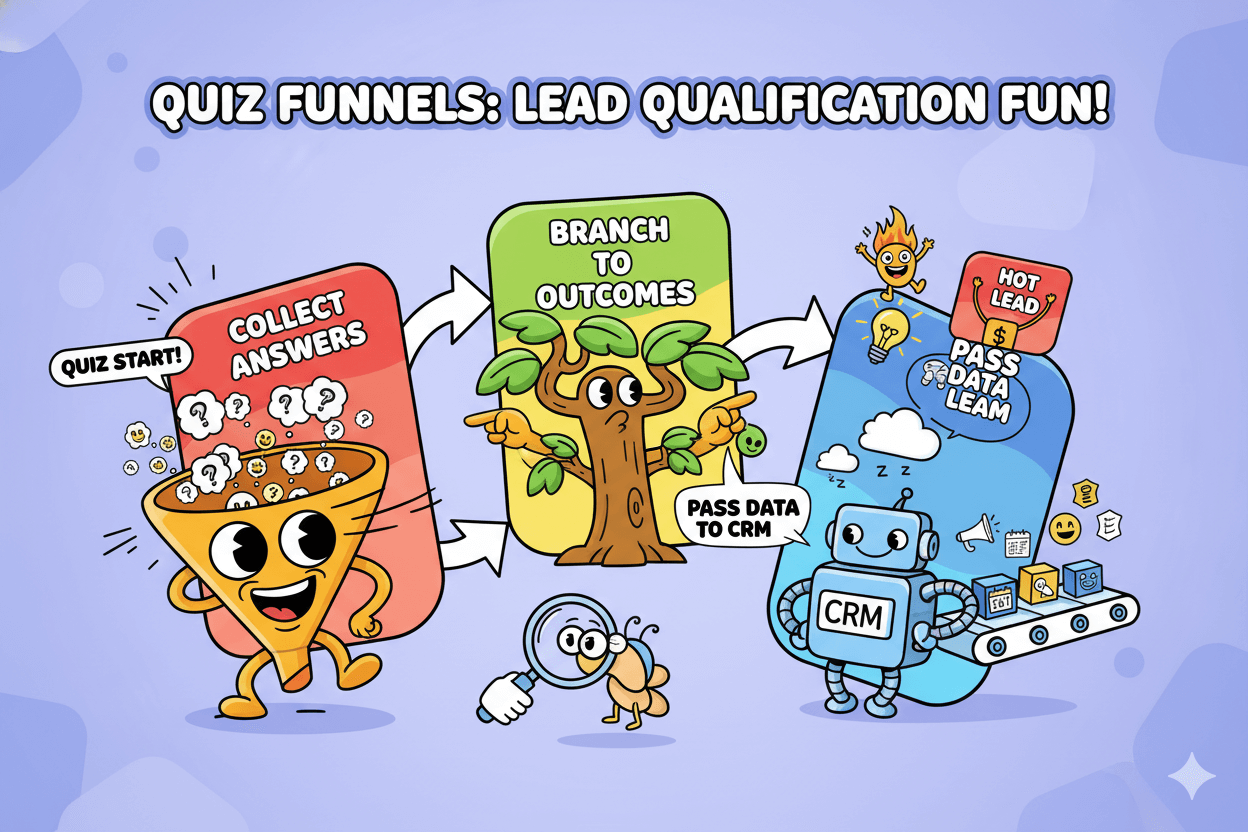
Quick answers set 2
Can chatbots book meetings automatically?
Yes. Sales-focused chat can qualify against your rules and book the right rep’s calendar in real time; several platforms document end-to-end flows across chat and forms.
What first-party data should I collect?
Capture declared needs, role, timeline, and budget ranges via quiz or chat, plus behavioral signals like pricing views and return visits. This supports compliant personalization and accurate scoring.
Do I need predictive scoring to start?
No. Begin with transparent, rules-based scoring in your CRM. Add predictive methods only after you’ve accumulated labeled outcomes and can compare lift against your baseline.
How do I test personalization and show pipeline lift?
Run an A/B or holdout. Track quiz completion, qualified rate, booked meetings, SQL rate, pipeline value, and response time. Attribute deltas to the treatment versus control.
How do I route leads instantly from forms?
Qualify server-side, match to owner/pool, and present the correct calendar right after submit. This “instant inbound” motion compresses response time and preserves intent.
Conclusion
You’re ready to ship the shortest path to pipeline: personalize the page for intent, invite a short quiz or guided chat, score the moments that signal heat, and route qualified visitors to a live calendar in minutes.
Customers now expect relevance, and recent roundups show personalization is both widely adopted and funded… which means simple, first-party tactics can move the needle fast.
Make speed your edge.
The classic lead-response research shows contact and qualification odds peak in the first five minutes and fall hard after that; modern playbooks operationalize the fix with instant routing and embed-at-submit scheduling so hot leads meet the right rep without delay.
Put a five-minute SLA on the board, wire alerts and failovers, and measure lift in booked meetings and SQL rate against a small holdout.
Start today: three segments, one dynamic CTA, a 7–10-question quiz, a simple additive score, and instant booking for those who qualify.
Keep it lightweight, consent-first, and measurable. Iterate weekly as data grows, then layer smarter automation. The result is a website that greets visitors like a helpful guide and turns intent into conversations—within minutes.
Keep the data clean, keep the page simple, and keep the clock in your favor.

Qualify Website Visitors in Minutes—Right on the Page

No-Code Personalization for Small Teams

Personalized Paths That Sell


